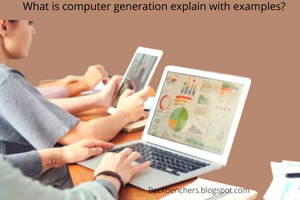What is computer generation explain with examples?
What is computer generation explain with examples?
 |
| Picture: Computer generation |
The computer device has gone through various stages of evolution and development to its present state. A stage or stage of evolution, change, and development of computer devices is called computer generation.
Although there is some disagreement about the generation of computers, the generation of computers can be divided into five parts on the basis of mechanical change, expansion, and development.
What do you mean by computer generation?
Answer: Computer Generation: Computer Generation or Generation means its technological evolution. Computers have gone through various stages and come to their present state. Each stage or stage of change or development is called individual generation.
The practice of sharing computers as a generation was introduced from an advertisement of IBM company. The generation of computers has been divided on the basis of its mechanical changes and development.
Computer Generation, Features, and Examples
1. First
generation: 1951-1958.
2. Second
generation: 1958-1965.
3. Third generation:
1965-1971.
4. Fourth
generation: 1971-present.
5. Fifth generation: The next day.
Examples of first-generation computers
1. The computer had a system for storing instructions and information.
2. The computer was large in size.
3. Vacuum tubes are used.
4. Their data storage capacity was limited.
5. Electronic waste magnetic trump card magnetic was used.
Examples: ENAIC, EDSAC, HINACKMARK, IBM-650, etc.
Examples of second-generation computers
1. This generation of IC or integrated circuits is invented.
2. Transistors began to be used instead of vacuum tubes.
3. The computer becomes smaller in size.
4. The temperature problem is solved.
5. The use of magnetic cell memory begins.
6. ASCII code was introduced.
7. Hardware, as well as software development, is achieved.
8 . High-level languages such as COBOL, FORTRAN, ALGOL, etc. emerge.
Examples: IBM-1620, CDC-1604, NCR-300 etc.
Examples of third-generation computers
1. The mouse is introduced as an input device with the keyboard.
2. Computers are relatively fast and cost less.
3. Video and printer are introduced as output.
4. Computer memory usage begins.
5. Increases computer skills and efficiency.
6. The use of semiconductor memory begins.
7. Basic languages, word processing, and various application programs are emerging.
Examples: IBM-370, PDF-8, PDF-11, etc.
Examples of fourth-generation computers
1. The introduction of microprocessors and semiconductors began.
2. Memories like ROM, RAM, PROM, EPROM, etc. are invented.
3. Emergence of massive capacity occurs.
4. DOS, Mac, Windows, and Unix Linux Nature operating systems are introduced.
5. The emergence and introduction of multiple application programs began.
6. The widespread use of microcomputers began.
7. The emergence of the supercomputer.
Examples: IBM-3033, HP-3000, IBM-4341, IBMMPC, IBM Compatible, PC etc.
Examples of fifth-generation computers
1. Computers of this generation will be equipped with artificial intelligence.
2. Computers can make hundreds of millions of logical decisions every second.
3. Computers can perform functions by converting human language into their own language.
4. Fiber optics will be introduced in computer circuits.
5. Huge power supercomputers will emerge and so on.
See more posts: Who contributes to the development of ICT



Timely post,Very knowledgeable.Keep it up.
ReplyDelete